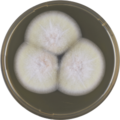| Aspergillus roseoglobulosus | |
|---|---|
| Scientific classification | |
| Kingdom: | Fungi |
| Division: | Ascomycota |
| Class: | Eurotiomycetes |
| Order: | Eurotiales |
| Family: | Aspergillaceae |
| Genus: | Aspergillus |
| Species: | A. roseoglobulosus |
| Binomial name | |
| Aspergillus roseoglobulosus Frisvad & Samson (2004) [1] | |
Aspergillus roseoglobulosus is a species of fungus in the genus Aspergillus . It is from the Circumdati section. [1] The species was first described in 2004. [1] It has been reported to produce ochratoxin A, penicillic acid, xanthomegnin, viomellein, and vioxanthin. [1]
In 2016, the genome of A. roseoglobulosus was sequenced as a part of the Aspergillus whole-genome sequencing project - a project dedicated to performing whole-genome sequencing of all members of the genus Aspergillus. [2] The genome assembly size was 35.82 Mbp. [2]

